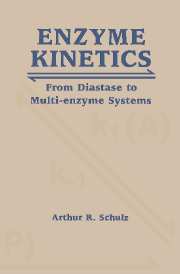Book contents
- Frontmatter
- Contents
- Preface
- Part One Basic steady state enzyme kinetics
- Part Two Enzyme reaction sequence
- 5 Multi-reactant enzymic reactions
- 6 Analysis of multi-reactant enzyme kinetics
- 7 Prediction of reaction sequence
- 8 Enzyme-catalyzed isotopic exchange
- 9 Kinetic isotope effect on steady state parameters
- 10 The effect of pH on enzyme kinetics
- Part Three Non-hyperbolic enzyme kinetics
- Part Four Control of multi-enzyme systems
- Part Five Solutions To problems
- Author index
- Subject index
9 - Kinetic isotope effect on steady state parameters
Published online by Cambridge University Press: 23 November 2009
- Frontmatter
- Contents
- Preface
- Part One Basic steady state enzyme kinetics
- Part Two Enzyme reaction sequence
- 5 Multi-reactant enzymic reactions
- 6 Analysis of multi-reactant enzyme kinetics
- 7 Prediction of reaction sequence
- 8 Enzyme-catalyzed isotopic exchange
- 9 Kinetic isotope effect on steady state parameters
- 10 The effect of pH on enzyme kinetics
- Part Three Non-hyperbolic enzyme kinetics
- Part Four Control of multi-enzyme systems
- Part Five Solutions To problems
- Author index
- Subject index
Summary
In the previous chapter, the enzyme-catalyzed isotopic exchange was considered as a means of obtaining information concerning the reaction sequence of an enzymic reaction. In the present chapter, the effect of isotope mass on the rate constants of those steps which involve the formation or cleavage of a covalent bond will be considered with respect to its effect on the steady state parameters. The basis for an isotope effect on the rate constants in which covalent bonds are formed or broken is discussed in detail elsewhere, and those discussions go beyond the scope of this book.
The basis for the kinetic isotope effect on rate constants
For the purpose of this treatment, it is sufficient to state that substitution of the normal atom in a covalent bond with an atom of greater mass will always favor formation of a stronger bond, and that will result in a decrease in the rate constants involved in the formation or rupture of that bond. For example, the rate constant for the non-enzymic formation or rupture of a R — H bond is approximately 15 times greater than the rate constant for the formation or rupture of a R — D bond. In the foregoing, H represents a hydrogen atom while D represents a deuterium atom. In like manner, the rate constant for the formation or rupture of a R — H bond is approximately 50 times greater than that for a R — T bond.
- Type
- Chapter
- Information
- Enzyme KineticsFrom Diastase to Multi-enzyme Systems, pp. 114 - 119Publisher: Cambridge University PressPrint publication year: 1994



